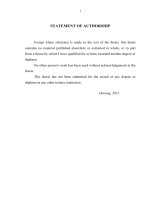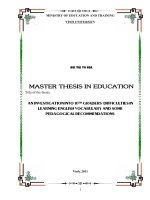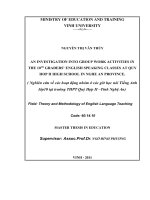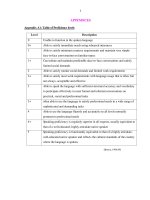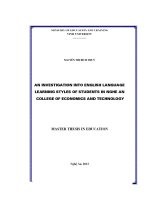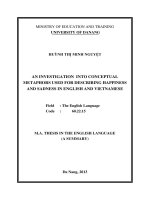An investigation into representatives in english lecture discourse
Bạn đang xem bản rút gọn của tài liệu. Xem và tải ngay bản đầy đủ của tài liệu tại đây (99.07 KB, 13 trang )
1
MINISTRY OF EDUCATION AND TRAINING
UNIVERSITY OF DANANG
***********
NGUYEN THI TRA MY
AN INVESTIGATION INTO
REPRESENTATIVES IN ENGLLISH
LECTURE DISCOURSE
M.A. THESIS IN THE ENGLISH LANGUAGE
(A SUMMARY)
DANANG - 2010
2
CHAPTER 1
INTRODUCTION
Research on the discourse of lectures is becoming more and
more relevant in recent years. Teachers involved in the field of
academic study have a wide range of instructional material available
namely, speech events such as seminars and tutorials; materials such as
videos; or activities such as writing assignments, among others; but the
lecture “remains the central instructional activity” [Flowerdew, 1994].
The lecture class is changing [Waggoner, 1984], so that
traditional methods of learning coexist with newer interactive methods;
both lecturers and students feel the influence of a greater egalitarianism
than in former times. Students see teachers much closer and the figure of
a helper, a counselor or a facilitator for the learning process better fits
their perspectives. On the other hand, teachers seem to invite students to
interact and participate more than in previous times, what may be
understood as an attempt to narrow distances and avoid formalisms and
foster students’ interest as well as motivate their initiative.
Lecture discourse is the representative of informative discourse
whose the ultimate purpose is to communicate information effectively.
In such an informative discourse, representative speech act covers
almost the lecture. In a lecture, it is simple to recognize a representative
in form of a declarative sentence such as ‘The North Atlantic Treaty
Organization, or NATO, is a defensive alliance first formed in the cold
war’ but it is not easy at all to recognize a representative in some other
different internal structures. Let me take the sentence ‘Remember that
an autobiography is a detailed story of our life, usually from childhood
to old age’ as an instance. This sentence has two functions that are
commanding listener to remember the proposition ‘an autobiography is
a detailed story of our life, usually from childhood to old age’ and
asserting ‘It is the fact that an autobiography is a detailed story of our
life, usually from childhood to old age’. For the former function, it is
recognized as a directive speech act while for the latter function, it is
3
considered as a representative speech act. In other words, the above
instance has primary speech act as a representative and secondary
speech act as a directive or we can say that is a representative in form of
an imperative sentence.
Representatives in lecture discourse are expressed not only by
statements but also by some other internal structures such as
interrogative and imperative and exclamatory. Nevertheless, the reason
why lecturers have tendency of using different structures to perform a
representative speech act urges me to investigate whether there are
something these different structures imply and how can recognize those
kinds of representative speech acts. The ways of making best uses of
structures which are going to be brought into light also attracts me.
Accordingly, this investigation is concerned with
representatives in English lecture discourse with the hope of
discovering useful internal structures, their syntactic realization and
their semantic functions in order to partly help lecturers give their
lectures effectively and successfully.
1.2. AIMS AND OBJECTIVES
1.2.1. Aims
This study aims to investigate representatives in English
lectures in order to find out their internal structures, their syntactic
realization and their semantic functions beside their ultimate function of
imparting or communicating information. Syntactic structures that
imply representatives will be also examined so that some popular and
effective language which helps lecturers be successful can be suggested.
1.2.2. Objectives
This study is intended to:
- To find out the internal structure and syntactic realization of
representative speech act in English lecture discourse.
- To discover some common syntactic structures which imply
representative speech act in English lecture discourse.
4
- To investigate some other functions which representatives in
English lecture discourse might have.
- To suggest some effective language techniques used in
English lecture discourse with the hope of having effective and
interesting lectures.
1.3. QUESTIONS OF THE STUDY
The purpose of this study is to answer the following questions:
1. Where are representatives distributed in an English lecture?
2. What are the internal structures of a representative in an English
lecture?
3. What are kinds of syntactic realization of a representative in an
English lecture?
4. What kinds of functions do representatives in an English lecture have
with regard to the ultimate purpose of informative discourse?
1.4. SCOPE OF THE STUDY
The study is confined to English lectures of various subjects.
The researcher was unable to attend real lectures in person, 720 lectures
including 280 interactive lectures and 440 academic lectures at different
levels from TOFLE iBT recordings were taken.
1.5. TERMINOLOGY
1.5.1. Internal structure
Internal structure is recognized as deeper structure. In this
study, it implies declarative, imperative, interrogative, and exclamatory.
1.5.2. Syntactic realization
Syntactic realization gives us the way an internal structure is
expressed. They are declarative statement, imperative sentence,
interrogative sentence, and exclamative.
1.5.3. Syntactic structure
Syntactic structure is the smallest unit in this study. It shows the
parts in a syntactic realization such as Subject, Object, Complement,
Verb phrase, and so forth.
5
1.6. ORGANIZATION OF THE STUDY
The thesis consists of 5 chapters as follows:
Chapter 1: “Introduction”, states the rationale, the aims and objectives
of the study, the scope of the study, and the research questions.
Chapter 2: “Literature Review and theoretical background”, deals with
necessary understanding about lecture discourse, reviews background
on speech act theory of Searle and on representative speech act. The
differences between notions of primary speech act and secondary
speech act will also be presented. And the review of previous studies is
the last part of this chapter.
Chapter 3: “Research design and data analysis”, presents the research
design, the sample, data collection, and research procedures.
Chapter 4: “Finding and Discussion”, presents the summary of data
collected, their analysis and discussions on the internal structures,
syntactic realization and semantic functions of representative in English
lecture discourse.
Chapter 5: “Conclusion and recommendation”, draws conclusions and
suggests some implications basing on the results in previous chapter.
6
CHAPTER 2
LITERATURE REVIEW
AND THEORETICAL BACKGROUND
2.1. DISCOURSE AND DISCOURSE ANALYSIS
The term 'discourse' has taken various, sometimes very broad,
meanings. Originally the word 'discourse' comes from Latin 'discursus'
which denoted 'conversation, speech'. Discourse analysis gives us
insight into various aspects of language in use: how texts are structured
beyond sentence level; how talk follows regular patterns in a wide range
of different situations; or how discourse norms and their realization in
language differ from culture to culture. Moreover, this theory has many
practical applications above and beyond knowledge about language for
its own sake. Discourse analysis is currently being used to give us a
better understanding of the nature of language use in specific fields such
as teaching or science. It enables us to find out why some chunks of
language are more effective than others in both written and spoken
forms at communicating information. The nature of information
communicating, of success or failure of lectures, or of how breakdowns
in communication can occur can come into light via the tools of
discourse analysis.
2.2. LECTURE DISCOURSE
Lecture discourses are representative of informative discourses
or expository discourses. The ultimate purpose of an informative
discourse is to communicate information effectively.
2.1.1. Lecture styles
Several studies have identified a number of lecture styles.
Morrison [1974, reported in Jordan 1989, p.153] studied science
lectures and divided them into two kinds: i) formal and ii) informal. The
former refers to “close spoken prose”, and the latter is defined as “high
informational content, but not necessarily in high formal register”. This
first classification, although somehow useful, seemed too simplistic for
such a complex speech event. More complete classifications of lecture
7
styles are those proposed by Goffman [1981], Dudley-Evans and Johns
[1981] and Dudley-Evans [1994]. This last study points out that: “the
key to the understanding of lectures is an appreciation of lecturers’
individual styles” [Dudley-Evans, 1994, p. 148]. Goffman [1981] talks
about three modes of lectures, namely, ‘memorization’, ‘aloud reading’
and ‘fresh talk’ whereas Dudley-Evans and Johns [1981, p.134]
distinguish three styles:
i) The reading style, “in which lecturers either read the lecture
or deliver it as if they were reading it” [Dudley-Evans,
1994, p. 148].
ii) The conversational style, “in which lecturers deliver the lecture
from notes and in a relatively informal style with a certain amount
of interaction with students” [Dudley-Evans, 1994, p. 148].
iii) The rhetorical style, “in which the lecturers give a
performance with jokes and digressions” [Dudley-Evans,
1994, p.148].
There is no written evidence about the frequency of use of lecture
styles, but there seems to be a general agreement on identifying the
informal conversational style –based on notes or handouts– as the
predominant mode of lecture presentation not only for native, but also for
non-native audiences [McDonough, 1978; DeCarrico and Nattinger,
1988; Dudley-Evans, 1994]. Along this line, Frederick [1986] talks about
a “participatory lecture” closer to discussion. More recent work [Benson,
1994] perceives a move towards a more interactive style of lecturing.
2.1.2. Syntax of Lectures
Regarding the syntax of lectures, these, as a type of spoken text,
might be seen as characterized by typical spoken syntactic features
rather than by written features [Tannen, 1982, Halliday, 1985, p.89].
There are several mechanisms in spoken discourses which
facilitate learners’ comprehension; the use of linguistic repetition, as an
example, plays an important role. Some research on the linguistic
8
repetition considers that this type of repetition is relevant as a means of
cohesion and global structuring of the discourse [Van Dijk et al., 1972].
In a recent study on lectures, Giménez [2000] analyses the
effects of linguistic repetition on the academic genre of lecture within
the discourse of Social Sciences. Giménez [2000] presents proven
evidence of the importance of linguistic repetition in the genre of
lecture for a logical understanding.
2.1.3. Lecture Structural Patterns
The structuring and organization of a lecture plays an important
role for the listening comprehension process.
Cook [1975] distinguishes two structural patterns within a
lecture: the macro-structure and the micro-structure of a lecture. Cook’s
[1975] attempt describes the boundaries of these units but fails to give
detailed information about their internal structure.
More recent work by Young [1994] tries to “describe the
macro-structure of university lectures and to identify some of the more
prominent micro-features that contribute to this structure” [Young
1994, p. 159]. Young describes the macro-structure of a lecture in terms
of ‘strands’ or ‘phases’.
2.3. SPEECH ACT
2.3.1. An overview on Searle’s speech act theory
This section contains a summary of Searle's speech act theory. It is
based primarily on the analysis developed in [Searle, 1979], which is a
major improvement of the earlier work as described in [Searle, 1969].
In order to classify speech acts, Searle applies three primary
dimensions. These are the illocutionary point, the direction of fit, and
the sincerity condition.
2.3.2. Classification of illocutionary act
Searle [1969] suggested 5 types of speech acts which are:
representative, directive, commissive, expressive and declaration.
9
2.3.3. Felicity conditions
Here come the felicity conditions provided: preparatory,
sincerity, essential and propositional content conditions.
2.3.4. Indirect speech acts
Searle has introduced the notion of an 'indirect speech act',
which in his account is meant to be, more particularly, an indirect
'illocutionary' act.
In connection with indirect speech acts, Searle introduces the
notions of 'primary' and 'secondary' illocutionary acts. The primary
illocutionary act is the indirect one, which is not literally performed.
The secondary illocutionary act is the direct one, performed in the
literal utterance of the sentence [Searle, 178].
2.3. POLAR INTERROGATIVE VERSUS CONSTITUENT
INTERROGATIVE
Polar interrogatives are typically used to inquire about the truth or
falsity of the proposition they express. In short, they are recognized as
Yes/No questions in the study.
Constituent interrogatives are also known by the name
‘information questions’, receive answers that provide the kind of
information specified by the interrogative word (WH-words like who,
when, how in English) contained in it, i.e. some expression denoting a
human being.
2.4. PRIOR RESEARCH ON THE STUDY
A great part of university discourse research focuses on the
lecture [Johns1981, Richards 1983, Benson 1989] and more specifically
on the lecture comprehension process. Knowing the best way for
students to internalize and comprehend lecture content seems to be
paramount for university success; that is why there is some research on
spoken academic language centered on different aspects of lectures
[Flowerdew, 1994, Chaudron & Richards; 1986, Thompson, 1994;
Jones, 1999; Khuwaileh, 1999; Kerans, 2001].
10
Spoken text has its own lexico-grammatical features, which
require the application of particular sets of knowledge on the part of
listeners [Biber, 1988].
Some researchers have identified a set of micro-skills which are
assumed to be necessary for the comprehension of lectures in a second
language. The first of these micro-skills taxonomies was the one
proposed and designed by Munby [1978], becoming a departing point in
any needs analysis and course design. Based on Munby [1978],
Richards [1983] provided a second taxonomy much more closely
related to academic listening.
Olsen and Huckin [1990, p.33] point out that students: “may
understand all the words of a lecture (including lexical connectives and
other discourse makers) and yet fail to understand the lecturer’s main
points or logical arguments”. Therefore, the use of strategies is relevant
for the comprehension of lectures, both for teachers and learners.
There are a lot of great works have been done which have
contributed important parts to the art of giving lectures. However, there
is no previous research taking representative illocutionary act and its
contributions to English lectures into consideration. As it was born to
be, representative is conventionally used in every lecture to impart
knowledge or communicate information. However, it stills shows some
other sub-functions that people may not notice or give it enough
consideration. And those other functions may reveal some things which
give us a chance to discover deep and useful information from native
professors that give us clearer and deeper understanding about the art of
giving lectures as well as the art of teaching.
11
CHAPTER 3
RESEARCH DESIGN AND DATA ANLAYSIS
3.1. RESEARCH DESIGN
3.1.1. Quantitative and qualitative methods
In order to examine and analyze the linguistic characteristic
features of the representatives in lecture discourse, I combine
qualitative and quantitative approaches. The qualitative method was
used to gather the information about the characteristics and categories
of representatives from the data. The quantitative method also helps
with the collection and analysis of numbers and statistics. The
qualitative method was used for grouping internal structures, syntactic
realization and semantic functions relying on the quantitative analysis.
3.1.1. Descriptive and comparative methods
In order to provide in-depth and detailed descriptions of
representatives in lectures, the study was obviously descriptive in nature. In
embarking on this analysis, frequent comparison between the groups of
data found was also aimed at in order to highlight the critical discussion.
3.2. RESEARCH PROCEDURE
This study was planned and carried out on the basis of a
qualitative and quantitative analysis. The analysis chiefly concentrated
on representatives in English lecture discourse. Herein after are the
steps strictly followed in this study:
+ Collecting data from TOEFL iBT extracts of lectures both in
form of texts and audio files
+ Observing various sentence types which reveal different types
of speech acts
+ Setting up the corpora of samples of representatives picked
out from extracts of lectures by using the table of felicity conditions on
different types of speech acts (drawn from Searle’s speech act theory
[1969]) 3.1 below to identify representatives expressed by different
forms as well as to analogy those of not representatives
12
Table 3.1. Felicity conditions on different types of speech acts
Preparatory
Representative
(Assertion)
Sincerity
Essential
Propositional
content
Sp believes S believes p. Counts as an Any p.
H does not
assertion of p.
know p.
Sp believes Sp wants to Counts
as Future A of H.
H able to do do A.
attempt to get
Request
A.
H to do A.
Directive
Sp does not Sp wants to Counts
as
know p.
know p.
attempt
to
Question
elicit p from
H.
1. S believes Sp intends to Counts
as
Commissive
H wants A do A.
obligation to
(Promise)
done.
do A.
feels Counts
as
Sp believes Sp
Expressive
A benefits S. appreciation expression of
(Thanking)
for A.
appreciation
for A.
Sp
has Sp intends to Counts
as
Declaration
authority to name X.
naming of X.
(Naming)
name X.
Any p.
Future A of
Sp.
Past A of H.
Name for X.
(KEY: Sp = speaker, H = hearer, A = act, p = proposition)
+ Selecting the internal structures which are quite popular in the
corpora such as declarative, imperative and exclamatory
+ State the statistics of those internal structures
+ Presenting, describing, analyzing and comparing groups of
information in the corpora in terms of linguistic with the illustration of
tables
+ Discussing the results in terms of linguistic and semantic
features with the summary for each in forms of tables
+ Making some pedagogic implications.
13
3.3. SAMPLE
The sample of a representative speech act ranged from a simple
sentence, a sequence of sentences that realize the speech act function of
a representative in a lecture. 720 extracts of lectures were taken from
TOEFL iBT recordings to serve the study.
3.4. DATA COLLECTION
The instrument for data collection is the observation with the
searching instances of representatives used in lectures. Those instances
of utterances which fulfill the functions of imparting knowledge and
facilitating this essential function in lectures were regarded as instances
of representatives.
3.5. DATA ANALYSIS
The data analysis was done qualitatively and quantitatively.
Samples of representatives were analyzed according to the following
dimensions set by the research questions:
+ The common internal structures of a representative speech act
in an English lecture discourse;
+ The syntactic realization of representatives in an English
lecture discourse;
+ The semantic functions that representatives in an English
lecture discourse have with regard to the ultimate purpose of
informative discourse.
3.6.
RELIABILITY AND VALIDITY
The data collection of this study was done with the major
sources which are the lectures extracted from English interactive and
academic lectures from the TOEFL practice test recordings. In addition,
the statistics which show the numbers and percentages of
representative’s internal structures, syntactic realization, syntactic
structures as well as the examples were exactly and faithfully presented.
The research procedure was strictly and logically done with the purpose
of identifying representatives exactly.
14
CHAPTER 4
FINDING AND DISCUSSION
4.1. FINDINGS
The findings were grouped into three sections. The first one
dealt with the classification of secondary speech acts the illocutionary
force or point of which are those of representatives. Meanwhile, the
second considered how representative speech acts were expressed by
internal structures and their distribution. Thirdly, their syntactic
realization was also presented.
The communicative function in lecture of a representative
speech act can be performed by a representative itself, a directive, or an
expressive. It can be noted that almost every speech act may have more
than one illocutionary acts, one is secondary speech act and the other
one(s) can be primary one. Their primary and secondary illocutionary
acts may be different or may be the same. The speech acts that I tried to
discuss were supposed to have their primary illocutionary acts as
representatives. And the terms “representative”, “directive”,
“exclamatory” are implicit to their secondary illocutionary acts.
In order to provide the concise and condensed overview on the
syntactic realization and semantic functions of representative speech
acts in lectures, tables which include clear instances and analysis will be
presented below instead of presenting a plenty of words.
Table 4.7. Syntactic realization and syntactic structure of
representative in form of declarative sentence
Primary Speech act
Representative
Secondary Speech act
Representative
Syntactic realization
Statement
Internal structure
Declarative
Syntactic structure
E.g.
Subject
Predicate
(Complement)
The North Atlantic is
a defensive alliance
Treaty Organization,
first formed in the
or NATO
cold war….
15
Communicated
message
16
Table 4.11. The fourth syntactic realization and syntactic
structure of representative in form of imperative sentence
It is the fact that The North Atlantic Treaty
Organization, or NATO, is a defensive alliance …
Cognitive status of P
This is a default case of a typical representative where
Primary Speech act
Representative
the validity of the proposition of the statement is taken
Secondary Speech act
Directive
for granted
Syntactic realization
Positive Imperative
Internal structure
Table 4.8. The first syntactic realization and syntactic structure
of representative in form of imperative sentence
Primary Speech act
Directive
Syntactic realization
Positive Imperative
Internal structure
E.g.
Imperative
Imperative clause
Remember
Complement clause
that the interior of Earth is
extremely hot…
Communicated
It is the fact that the interior of Earth is extremely
message
Cognitive status of P
E.g.
Imperative
Imperative clause
Find out
Representative
Secondary Speech act
Syntactic structure
Syntactic structure
hot…
P is required to be remembered as a fact worth to be
recalled
Table 4.9. The second syntactic realization and syntactic
structure of representative in form of imperative sentence
Complement clause
how it gathers information,
then work against it….
Communicated
It is presupposed that it gathers information
message
Cognitive status of P
P is required to be treated as an uncovered fact
The table 4.8 was used to illustrate the use of imperative to act
a representative in the effort of emphasizing or marking the core
information coming right after ‘Remember that’. Besides; the table 4.9
presented the use of imperative to give instances in an effective and
flexible way. In addition, the table 4.11 stated the use of imperative to
act a representative as it describes the steps in giving instruction
procedure.
Table 4.12. Syntactic realization and syntactic structure of
representative in form of polar question
Primary Speech act
Representative
Representative
Secondary Speech act
Directive
Secondary Speech act
Directive
Syntactic realization
Polar Question
Syntactic realization
Positive imperative
Internal structure
Imperative
Syntactic structure
Primary Speech act
Internal structure
Syntactic structure
Imperative clause
E.g.
Let’s say
Communicated
message
Cognitive status of P
Interrogative
Auxiliary
Subject
E.g.
Did
you could buy an affordable fuel
Communicated
Either the Sumerians really disappear or they continue
cell powered car today…
message
Complement clause
It can be a typical case that you could buy an
affordable fuel cell powered car today…
P is required to be considered as an exemplar case
Cognitive status of P
the Sumerians
Verb
really disappear
to live among us to this day
P is required to be treated as attracting audience’s
mind
17
Table 4.13. Syntactic realization and syntactic structure of
representative in form of constituent question
Primary Speech act
Representative
Secondary Speech act
Directive
Syntactic realization
Constituent Question
Internal structure
Syntactic structure
Interrogative
Constituent
Auxiliary Subject Verb phrase
Interrogative
word
E.g.
How
could
you
control …
country?
Communicated message
Cognitive status of P
you could not control … country
P is required to be treated as a null hypothesis of a
possibility of realizing P
Table 4.14. Syntactic realization and syntactic structure of
representative in form of exclamatory
Primary Speech act
Representative
Secondary Speech act
Exclamative
Syntactic realization
Exclamation
Internal structure
Exclamatory
Syntactic structure
Predicator
E.g.
Excellent!
Communicated
message
Cognitive status of P
You could buy an affordable fuel cell powered car
today…
P mentioned in student’s response is judged to be
true; and P is recognized with appreciation
18
Table 4.15. Semantic functions of representative speech acts in form of
declarative sentence
Primary Speech act
Representative
Syntactic realization
Statement
Internal structure
Declarative
Function
Asserting
E.g.
It’s true that expansionary monetary policy can lead to
inflation, …
Communicated
[expansionary monetary policy can lead to inflation]
message
is true
Performative Force I assert that expansionary monetary policy can lead to
inflation, …
Table 4.16. Semantic functions of representative speech acts in form of
imperative sentence
Primary Speech act
Representative
Syntactic realization
Positive Imperative
Internal structure
Imperative
Function
Commanding and Asserting
E.g.
First, begin your name …
Communicated
The procedure begins with the information of your
message
name given …
Performative Force I command you to follow these steps and take each of
them as a chunk of instructional information …
Table 4.17. Semantic functions of representative speech acts in form of
interrogative sentence
Primary Speech act
Representative
Syntactic realization
Question
Internal structure
Interrogative
Function
Question and Asserting
E.g.
So, what can we do to combat these people?
Communicated
We can combat these people by what I am going to
message
tell you right now
Performative Force I am asking you to pay attention to the information I
give you after the question
19
Table 4.18. Semantic functions of representative speech acts in form of
exclamatory
Primary Speech act
Representative
Syntactic realization
Exclamation
Internal structure
Exclamatory
Function
E.g.
Communicated
message
Performative Force
Expressing and Asserting
Excellent!
We can combat these people by what I am going to tell
you right now
I hereby recognize the validity/truth of your answer
and highly appreciate that
Through the data collected from the informative lectures in the
corpora, the internal structures of representative speech acts gradually
came to light. The syntactic realization of representatives in an English
lecture discourse, which are very common structure such as imperative
and interrogative, was also found. By analyzing many instances which
groups together in special intentions of the researcher, a full
understanding about semantic functions that representatives in an
English lecture discourse have with regard to the ultimate purpose of
informative discourse was presented. As teaching is an art, this study
contributes some useful and interesting ideas for the one who loves
teaching as a reference. The tables 4.18 and 1.19 below show the
concise and condensed summary of the whole chapter 4.
20
21
22
CHAPTER 5
CONCLUSION AND RECOMMENDATION
5.1 CONCLUSION
By studying the linguistic feature, the study covers two areas of
investigation: first, the pragmatic features and second, the semantic
features of representative in English lecture discourse. According to the
findings and the discussion presented preceded, a representative speech
act can be performed by a representative, a directive, or an expressive.
Every speech act may have two illocutionary acts, one is secondary
speech act and the other is primary one. Its primary and secondary
illocutionary acts may be different or may be the same. So do its
functions.
In order to have a clear-cut presentation for what were
concluded, the table below which summarizes the advantages i.e.
contributions of a representative to a lecture will be shown.
23
Table 5.1. Advantage of a primary representative speech act in
lecture discourse
Advantage
Internal structure
• Communicating
effectively
Declarative
information
directly
and
• Convey a big amount of information to a big
number of students in a limited time
• Attracting students’ attention
Imperative
• Marking the emphasis on important information
• Describing a procedure of giving instructions in a
clear-cut way
Rhetorical
question
• Communicating information in
an eliciting way
• Attracting students’ attention
• Functioning
marker
Interrogative
Tag question
as
a
thematic
• Appealing students’ agreement
• Narrowing
distance
from
students (being close to
students)
• Giving feedback
Exclamative
• Awakening emotion
• Encouraging students
5.2. RECOMMENDATIONS
Through this study, I would like to propose two big problems
that every lecturer might face in their work of giving lectures: students’
INATTENTION and their NOT cooperating. Accordingly, some
recommendations presented below try to suggest some techniques for
24
an effective lecture by using language and by organizing some
activities.
- Reset students’ attention every 5 minutes and every 20 minutes.
Students have short attention spans, according to some
observers, 15 or 20 minutes is as long as one can
expect. Therefore, at least the lecturer should reset their
attention slightly by using imperative sentences to have strong
and clear-cut emphasis on what he said. This is also a good way
to mini-summarize the content he said in 5 past minutes so that
students can follow him easily. He can also put a rhetorical
question which followed by a short period of silence. This
sudden change will be very effective in ways of asking for
students’ attention and thinking. After every twenty minutes, it
is useful to "reset" the attention by interjecting some activity by
the students. This could be as simple as asking students to
write a single sentence explaining the main point being
discussed, or to explain something that they have not
understood, or ask students NOT to take notes for a short
period, then work in groups to reconstruct what they heard.
- Intersperse group activities. For example, a twenty minute
lecture, followed by a ten minute group discussion, followed by
another twenty minute lecture can be much more effective than
50 minutes of straight lecture .The group work could be a
simple exercise such as "think-pair-share" or a more
complicated group activity.
- Make lectures interactive. Find a way to solicit feedback from
students during the lecture. During the lecture the lecturer
should scan the room for the student who is least engaged in
the lecture and then does whatever he needs to do to get that
student to pay attention (e.g., speak faster or slower, louder or
softer, tell a joke, or somehow change the pattern). Interactive
here also means the lecturer and his students can talk face to
25
face by asking and answering some questions. In case of giving
a question, the lecturer has to try NOT to forget to give a
positive feedback. His feedback plays an important role and has
serious impact on students’ attitude of learning. Positive
feedback here does not mean he should always give praises. It
does mean he can praise or criticize his student answer but it
must be in a tactful way.
- Help students organize their notes. The lecturer can help
students retain the material by providing a structure and
emphasizing important points and connections. To do this well,
once again imperative and interrogative sentences are proved to
be the best means.
- Start with a problem that engages students. It is most effective
to start with something that hooks students into the topic. This
should associate with putting questions to interact with students
or giving rhetorical questions so that this tip can do its best.
5.3. SUGGESTION FOR FUTHER RESEARCH
I had a chance to investigate the structure of a lecture in English
and representative in English lecture discourse which gave me a lot of
nice ideas of giving an effective lecture. This is really an art and the
professors in the corpora were skillful artists. I learnt a lot from this
study. However, I would like to have another chance to investigate
representative in Vietnamese lecture discourse to have a contrastive
analysis between representatives in English lectures and Vietnamese
lectures. The differences in language, culture, custom, teaching style,
students’ attitude and some other factors might create some remarkable
and interesting alternatives.


